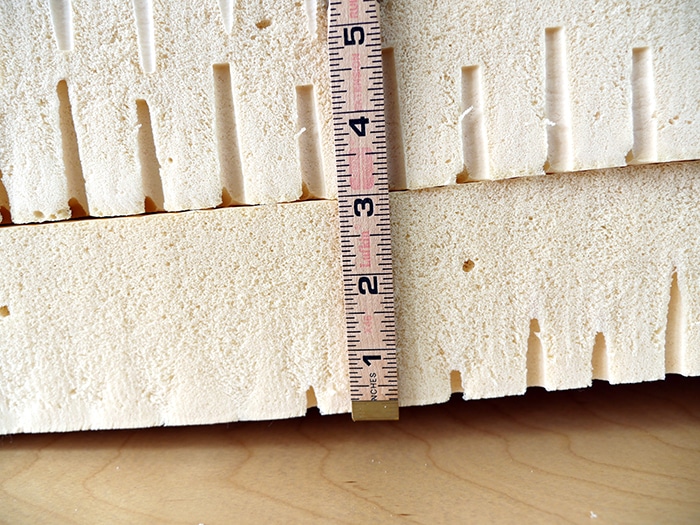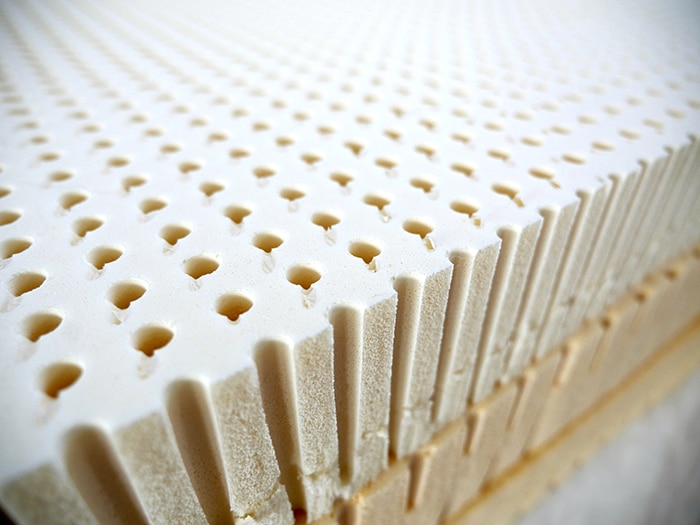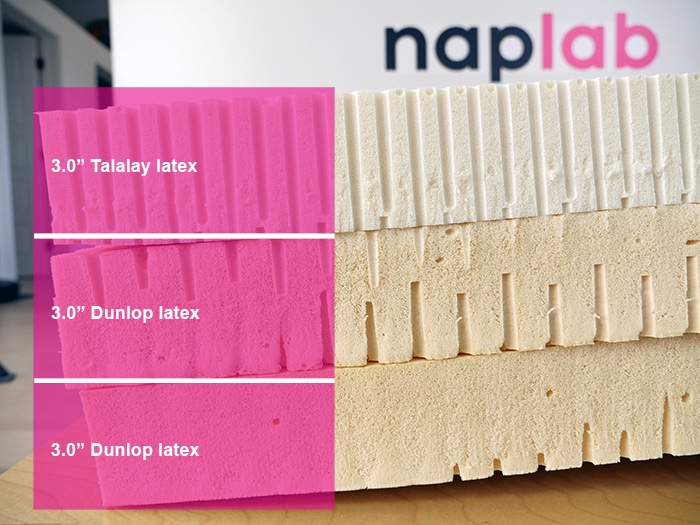Latex mattresses are known for their durability and comfort. And, unlike memory foam, latex foam is a natural material made from the sap of the rubber tree, or Hevea brasiliensis. Therefore, it’s more sustainable and eco-friendly.
Manufacturers use different methods to produce latex foam, with the most common being Dunlop and Talalay. The former results in foams with a denser, firmer feel, whereas Talalay latex is bouncier, lighter, and more breathable.
When it comes to Dunlop vs. Talalay latex, both foams are made from the same base material. Yet, they have distinct properties—and you may find one better than the other.
In This Guide
Dunlop Latex | Talalay Latex | Dunlop vs. Talalay | Which is best?
What is Dunlop Latex?
Developed in 1929, Dunlop is a manufacturing process used to make latex foam. It uses the sap of the rubber tree, which is mixed with other ingredients to achieve an airy consistency.

The resulting product is poured into a mold and processed in a vulcanizing oven. After that, it’s washed thoroughly to remove solvents and other additives. Lastly, the latex foam is heat-dried and cut into pieces of different sizes.
Generally, Dunlop latex is either organic or natural, but some manufacturers use synthetic materials or a blend of natural and synthetic compounds. Organic Dunlop latex foam is often labeled with the GOLS (Global Organic Latex Standard) label, which confirms its purity.
What Does It Feel Like?
Both Dunlop and Talalay latex foams are used in mattresses and other bedding products, such as mattress pads and toppers. Those made from Dunlop latex are often denser and more durable, but less breathable than those containing Talalay latex foam.
Dunlop latex is firm and responsive, which makes it suitable for mattress support layers. Although it’s not as bouncy as memory foam, it contours to your body and can help with pressure relief.
A potential drawback is that it may feel warmer due to its high density. However, it’s still typically cooler than memory foam.
What Is Talalay Latex?
The Talalay process has been around since the late 1940s and has continued to evolve over the years. At first sight, it’s quite similar to the Dunlop process, except that it involves two additional steps: vacuum sealing and freezing.
It all starts with the sap of the rubber tree, which is mixed with other materials and then poured into a mold. After that, the partially filled mold is vacuum-sealed, causing the latex foam to expand. Next, the latex is freeze-dried, vulcanized, and washed.

Talalay latex foam is natural, synthetic, or a mix of the two, but it cannot be organic. Since it costs more to produce than Dunlop latex, it tends to have a higher price tag.
What Does It Feel Like?
This material is lightweight, breathable, and responsive, offering more cushioning than Dunlop latex. However, this doesn’t necessarily mean it’s softer.
Both Dunlop and Talalay latex foams come in different firmness levels. The latter often has a more “plush” feel, but its firmness may vary from one mattress to another.
Talalay latex also tends to have a consistent feel. Dunlop latex, on the other hand, feels softer or firmer, depending on the amount of pressure applied to it.
Apart from that, Talalay latex is less dense than Dunlop latex foam. For this reason, it tends to be less durable but can still last 10 to 15 years or longer. By comparison, Dunlop latex mattresses have an average lifespan of 20 to 25 years.
It’s also worth mentioning that Talalay is often used in mattress comfort layers, toppers, pads, and some pillows due to its plushy feel. Since it’s more breathable than Dunlop latex, it may be a better choice for hot sleepers.
Dunlop vs. Talalay Latex: Which One Is Right for You?
Now that you know more about Dunlop vs. Talalay latex, let’s see how they stack up against each other.
| Dunlop Latex | Talalay Latex | |
|---|---|---|
| Organic | ||
| Comfort and feel | ||
| Bounciness | ||
| Consistency | ||
| Breathability | ||
| Durability | ||
| Sustainability | Sometimes | |
| Hypoallergenic | ||
| Lightweight | ||
| Price | ||
| Best for | Support layers | Comfort layers |
Note that some mattresses contain Dunlop and Talalay latex, offering the best of both worlds.
For example, the Sleep EZ Organic Latex mattress has three layers:
- 3.0” Talalay latex layer
- 3.0” Dunlop latex layer
- 3.0” Dunlop latex layer

These layers are interchangeable so you can swap them based on the preferred firmness level.
If, say, you’re a back sleeper, you can place the Dunlop latex layer on top for better support. But if you’re a side sleeper, you may feel more comfortable resting on Talalay latex foam.
Is Dunlop or Talalay Better?
Choosing between Dunlop and Talalay latex depends on your needs and budget.
Dunlop latex foam is firmer and more durable, and some would say it offers better value. Plus, it’s available in organic versions, too.
Talalay latex, on the other hand, may feel more comfortable and breathable. The downside is that it’s less sustainable and has a higher price tag.
That said, we recommend Dunlop latex mattresses to those who:
- Prefer organic products
- Prioritize durability
- Want a firm, dense mattress
- Sleep on their back or stomach
- Have a smaller budget
Talalay latex mattresses may be better for consumers who:
- Want a mattress with a cushioned, plush feel
- Prefer more responsive mattresses
- Prioritize pressure relief and contouring
- Tend to sleep hot
- Don’t have budget constraints
Note that both Dunlop and Talalay latex foams are often more responsive than memory foam. Also, both materials typically last longer than other types of foam.

As far as pricing goes, the difference between the two isn’t that significant. Plus, you can always look for discounts and special offers to cut costs.
Last but not least, their quality may vary from brand to brand. With either option, even minor changes in their composition can impact their feel, breathability, longevity, and other aspects. For further insights, see our guide to the best latex mattresses tested by our team.


